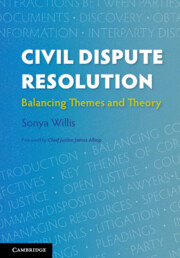Refine search
Actions for selected content:
10 results
Out with the Old, In with the Republicans? The Partisan Push of Legislative Term Limits
-
- Journal:
- Journal of Policy History / Volume 37 / Issue 1 / January 2025
- Published online by Cambridge University Press:
- 27 January 2025, pp. 22-47
-
- Article
- Export citation
3 - Constitutional context
- from Part I - Background
-
- Book:
- Modern Statutory Interpretation
- Published online:
- 05 January 2023
- Print publication:
- 10 January 2023, pp 36-46
-
- Chapter
- Export citation

Civil Dispute Resolution
- Balancing Themes and Theory
-
- Published online:
- 18 January 2022
- Print publication:
- 13 December 2021
-
- Textbook
- Export citation
Chapter 7 - A Hybrid Defense of the Legislative Perspective
- from Part II - Contemporary Approaches to the Rule-Consequentialist Paradox
-
- Book:
- Morality as Legislation
- Published online:
- 29 July 2021
- Print publication:
- 12 August 2021, pp 190-216
-
- Chapter
- Export citation
6 - Equivocal Democratic Accountability in the Anthropocene
-
- Book:
- Democratic Norms of Earth System Governance
- Published online:
- 12 August 2021
- Print publication:
- 29 April 2021, pp 123-137
-
- Chapter
- Export citation
6 - The Agora: Public Life and Administration
- from Part I - The Urban Fabric
-
-
- Book:
- The Cambridge Companion to Ancient Athens
- Published online:
- 10 March 2021
- Print publication:
- 18 February 2021, pp 86-97
-
- Chapter
- Export citation
Chapter 4 - Parliamentary institutions
- from Part 2 - Legal institutions
-
- Book:
- Learning Law
- Published online:
- 19 November 2020
- Print publication:
- 07 October 2020, pp 89-122
-
- Chapter
- Export citation
Considering Network Effects in the Design and Analysis of Field Experiments on State Legislatures
-
- Journal:
- State Politics & Policy Quarterly / Volume 19 / Issue 4 / December 2019
- Published online by Cambridge University Press:
- 01 January 2021, pp. 451-473
- Print publication:
- December 2019
-
- Article
- Export citation
6 - Admissions
-
- Book:
- Australian Uniform Evidence Law
- Published online:
- 12 April 2019
- Print publication:
- 22 February 2019, pp 204-258
-
- Chapter
- Export citation
4 - Delegated legislation
- from Part I - Administrative Decision-making
-
- Book:
- Government Accountability
- Published online:
- 12 December 2018
- Print publication:
- 23 October 2018, pp 89-128
-
- Chapter
- Export citation
